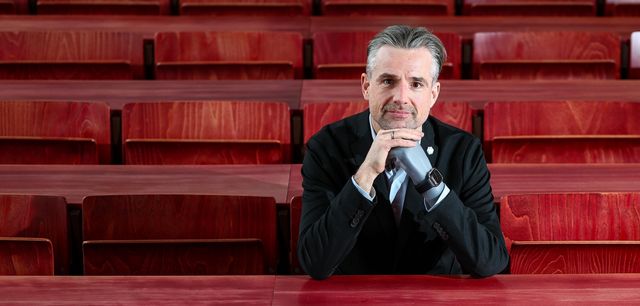30 October 2024
Some people look as if they have somehow become one with their smartphone; in general, technology is playing an increasingly important role in our everyday lives. But what happens when humans and technology literally merge? For psychologist Bertolt Meyer, Professor of Work, Organisational and Business Psychology at Chemnitz University of Technology, this has evolved from a purely personal to a scientific question.
Mr. Meyer, you grew up with a visible physical disability. What has been your experience in relation to that?
Bertolt Meyer: I’ve been missing my left forearm since birth. When you’re born with this sort of malformation, you have two experiences very early on: To start with, of course, you can’t do some things as well as other children. Archery, for example, which was really popular in my friendship group at different times, is very difficult with just one hand. But you will always find a way to get on in life with this sort of limitation, especially if you’ve never known anything else.
And the second experience?
This is actually the more problematic of the two. As a person with a disability, you’re often subjected to other people’s pity and condescension. Here’s an example: Some time ago we were out for dinner with the in-laws, with four of us sitting at the table. The waiter brought four plates, the only difference between them being that the meat had been cut up on mine. He meant it kindly, but to me it was just outrageous. Because I didn’t ask for help, nor did I need it.
What has the bionic prosthesis changed for you?
To my amazement, loads! Unlike older models, these modern bionic prostheses no longer look like an aid from a medical supply store. It’s more the case that you can see the high-tech in them. Since I’ve been wearing the bionic prosthesis, the pitying, embarrassed and sometimes even slightly disgusted responses that I used to be confronted with have suddenly given way to curiosity and interest. Children and young people in particular think it’s really cool. And “cool” is usually the opposite of “disabled”.
This personal experience led to a research question, didn’t it?
Yes: How does a visible technological upgrade of the human body affect how we see and interact with each other? So, what we did in several studies was to investigate scientifically how high-tech prostheses like mine change the way people with disabilities are perceived.
© Adobe Stock
An advantage? In competitive sport, says Prof Bertolt Meyer, athletes with prostheses tend to be viewed with suspicion.
© Adobe Stock
Support for physical work: modern exoskeletons help with lifting heavy objects - or in care work.
And what has the result been?
To put it bluntly, people with disabilities have to bear the stigma of being the “nice-but-dim disabled”; the general assumption is that they’re harmless but can’t do much for themselves. Our studies have now shown that bionic prostheses largely eliminate this stigma from the point of view of non-disabled people. Their wearers are considered to be almost as competent as the able-bodied. And the self-view of people with bionic prostheses also changes, as we found out in another study. They consider themselves more competent and feel empowered. This shows that, alongside its everyday usefulness, this technical body upgrade also has an enormous psychological effect.
And what about sport? What happens if a disabled person with a prosthesis outperforms athletes without disabilities?
Then things look different. The lower leg amputee long jumper Markus Rehm, for example, jumps further than any non-disabled long jumper in Germany. And then you quickly start hearing about “unfair advantages” or even “techno-doping”, because the person with a disability, who was previously ridiculed as inferior, becomes a competitor and threatens the status of the able-bodied athlete. But if you replace one exclusionary stereotype with another, namely that of the bionic man who is a cheat and a threat, then this does absolutely nothing to bring about a more inclusive society.
And what if “healthy” bodies are technically upgraded with an exoskeleton, for example?
We want to address this very question in further studies. After all, there are still lots of industrial work processes that simply can’t be made more ergonomic – or where to do so would be very expensive. In such cases, exoskeletons would be a solution to take the strain off the worker. The same applies to geriatric care, which is extremely physically demanding. Given the shortage of skilled workers and our ageing population, we need to improve working conditions. Exoskeletons are already being experimented with in various fields in these sectors. The question that concerns us is what this will mean for the self-view of the care workers and the residents of retirement homes.
Do you already have a theory as to what might happen?
The obvious assumption would be that the elderly residents would be afraid of the exoskeleton and, by extension, of the care workers themselves. But I don't think it's that simple. This is because social interactions always involve various factors that influence each other. If the carers’ work gets easier, they’ll be in a better mood when they interact with the residents and may even have more time for conversations, meaning that the residents will also feel better cared for – which might give them a positive association with the exoskeleton.
How do you generally view the technological possibilities that might await us in the future: with concern or with positive anticipation?
We can confidently say that neither the positive nor the negative forecasts have come true so far. Despite the predictions of labour sociologist Frithjof Bergmann in the 1970s, there’s no way we can say that advancing automation has meant prosperity for all or ensured that we all have to work less. On the positive side, nor have machines seized control or taken our jobs, as has been the recurrent fear. But what we can see is that, although new technologies may be making some jobs obsolete, like the telephone operator for instance, at the same time they’re also creating new fields of work. Just think of the armada of web designers who’ve been needed due to the development of the World Wide Web. You always have to be careful with future forecasts. However, I’ve become convinced that AI in particular will be ideally placed to relieve us of more and more arduous hard work in many fields in the future – to an extent that I would not have thought possible even just a few years ago. When you combine this with the ongoing development of robotics, we’re actually going to be able to get to the point of outsourcing monotonous, dirty and dangerous work to machines. However, this presupposes that we actually think about and design work in a human-centred way.
© Brix & Maas
About Bertolt Meyer:
Bertolt Meyer is Professor of Work, Organisational and Business Psychology at Chemnitz University of Technology. Among other things, the trained psychologist works with questions concerning the merger of human beings and technology and with diversity issues. Mr. Meyer also hosts science shows on Arte and Deutschlandfunk Kultur. In 2024, he was named “University Lecturer of the Year” by the German Association of University Professors and Lecturers.
What does that mean?
Until now, the dominant approach has been the technology-centric one: This means that companies automate all processes where it is possible and economical to do so. For the human workforce, this often leaves only incomplete auxiliary activities, by which I mean the “leftovers”, or the things that machines can’t do – yet, at any rate. Instead, our starting point should be human skills – we should be asking how we can use technology to support our human capabilities in such a way that work becomes healthier, more motivating and more fulfilling. This is why we mustn’t leave decisions like these exclusively to engineers and business economists or let them set the agenda; instead, we need to be discussing in society at large what positive and successful human-machine collaboration might look like.






